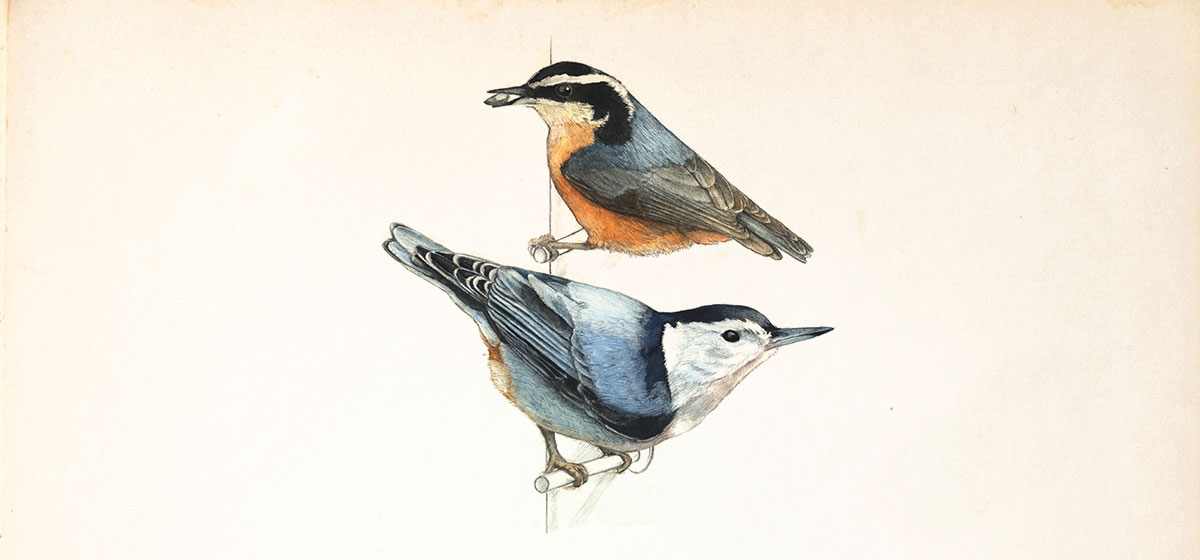
With winter’s chill approaching, most birds long ago migrated south. Migration actually begins in August and continues through the milder months of September and October. Birds wing their way to more abundant food sources, with some of Pittsburgh’s species heading deep into South America to tropical climes. A few hearty species winter in western Pennsylvania, either as year-round residents or visitors from farther north.
Two examples are the common White-breasted Nuthatch and its close and more peripatetic relative, the Red-breasted Nuthatch. Stubby, hunched birds, they use gripping claws to hoist themselves headfirst up and down tree trunks. They work their way around branches, down bark faces, and into every nook and cranny—fearless acrobats—to probe for insects, spiders and windblown seeds. The White-breasted (Sitta carolinensis) is 5.5 or 6 inches long and weighs about three-quarters of an ounce, with gray flanks and dark wing feathers. A short, black and white tail contrasts with white and rufous undertail coverts, the backend feathers. A white face and chest is offset above by a blue-black crown running down to its shoulders. Most notable is a probe-like beak—the perfect tool for this picky eater. The Red-breasted (Sitta canadensis) is an inch smaller and half the weight. Its bluish-gray back is similar in hue, but a peach-orange belly, underwings and chest, plus a bold white eyebrow, or supercilium, make the two easy to distinguish.
In winter, several adaptations help maintain body temperatures that normally hover around 107 degrees. The most obvious is feathers, which trap layers of air close to the birds’ bodies and keep them warm in their down coats. Eating regularly helps, too, and both species spend active hours hunting for small morsels, layering on fat as insulation. They also readily take human handouts, though they can survive without them. Nuthatches love sunflower seeds, peanut butter and suet (rendered fat). Full feeders will attract them to your home. They’re fearless and quick, so a feeder near a window will allow for close observation. You’ll see nuthatches grab a seed and quickly fly off, finding a quiet spot to crack it open and extract the meat. Sometimes, they’ll cache seeds to snack on later in the day. A feeder in winter often attracts a mixed flock of chickadees, titmice, nuthatches, woodpeckers and even goldfinches, so the competition can be fierce, but the benefits of group foraging make up for that. Ten pairs of eyes scanning for predators like a Sharp-shinned Hawk outweigh waiting in line at the feeder.
White-breasted Nuthatches thrive in Pittsburgh’s maturing deciduous woods, happily spending their days in backyards, in parks, and around edgy habitats near streams and clearings. Recent research suggests their numbers are on the rise, with summer nests hollowed in dead trees yielding five to nine eggs, a population of 560,000 or more statewide. Red-breasted Nuthatches, with closer to 30,000 in Pennsylvania, prefer coniferous forests, which explains their relative rarity in Pittsburgh. They reside more commonly in the evergreen tier of northern Pennsylvania, nesting inside rotting trunks and laying five or six eggs each spring. In fall and winter, if conifer seed crops are poor, Red-breasted Nuthatches head south and show up at our feeders. Listen for their nasal calls on winter mornings, similar in both species but delivered at different rates, especially after a storm has blown through and all is quiet under a falling of snow.
Fill feeders early and keep them well stocked. Beechwood Blend, available from the Audubon Society in Fox Chapel, is the best, least wasteful seed mix for our area. You’ll find other good choices at Wild Birds Unlimited. Beware of generic, bargain seed, which will attract squirrels and other less-welcome critters.


